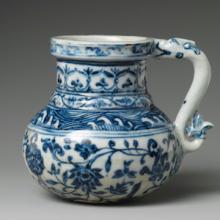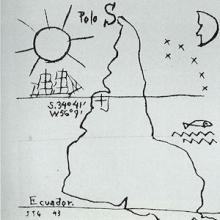Browse Primary Sources
Locate primary sources, including images, objects, media, and texts. Annotations by scholars contextualize sources.

Ottoman Reform Decree, 1856
The Imperial Reform Edict of Ottoman Sultan Abdulmejid I, appearing originally in 1856 and subsequently in this 1874 publication, promised equality of access to education, government appointments, military service, and administration of justice to all, regardless of religion, language, or race.
Poem by Qiu Jin, Chinese feminist
While the discussion surrounding the Chinese practice of footbinding often focuses on the writings of western missionaries, the example of Qiu Jin, a Chinese feminist and poet, demonstrates that the practice was criticized by Chinese individuals as well. Qui Jin had her feet bound as a child and as an adult spoke out against the practice.

Remains of Christopher Colombus
In October of 1492, the Spanish monarchs sponsored a voyage led by Columbus and his crew, who intended to sail towards India. Instead, they set foot in the Americas for the first time. Over the next several years, Columbus made many trips back and forth between Spain and the Caribbean Islands.

Portrait of Manuel Mansilla
This painting depicts Manuel Mansilla, the Alguacil Mayor (sheriff) of the city of Buenos Aires. He held this position from 1795-1821, during a key transitional moment. When he began his tenure, the city belonged to the Viceroyalty of the Rio de la Plata, under Spanish rule. However, by 1821, the region was establishing its independence as the nation of Argentina.

Mausoleum of José de San Martín
In 1816, after more than two centuries of Spanish rule, the nation of Argentina declared its independence. One of the leaders of the independence movement was José Francisco de San Martín y Matorras, more commonly known as General San Martín. He fought in battles in Argentina, Peru, and Chile. The Argentine public has historically regarded him as a father of the independence movement.

Legislative Palace of Uruguay
The Legislative Palace of Montevideo, Uruguay, was built in the early twentieth century. Construction lasted from 1904 to 1925 under the supervision of Vittorio Meano and Gaetano Moretti. It is located in the Aguada barrio, or neighborhood, of the city. Since Montevideo is the capital of the nation of Uruguay, the Palace houses the major legislative bodies of the nation.

Indian textile fragment, 14th-15th century
This block-printed, cotton textile fragment, found in Old Cairo, Egypt, was made in Gujarat, India. It features a repeated stylized tendril pattern made by stamping red-brown dye on the cloth in vertical sections.

Porcelain tankard, fifteenth century China
This Ming dynasty porcelain tankard incorporates some Chinese elements, such as the peony flower design on the body and the dragon-shaped handle. Its shape was not Chinese, however, but based on Islamic metalwork, which indicates it was made for export.

Ottoman Decree Regarding Protestants, 1850
This imperial decree, or firman, was translated from Ottoman Turkish to English by the American Board of Commissioners for Foreign Missions.

Cartoon about the Ottoman Empire
This cartoon appeared in the popular British magazine Punch on September 15, 1853. In it, France is personified based on the mustachioed Emperor Napoleon III, and Britain appears as the symbolic figure John Bull. They confer at the apparent deathbed of Abdulmecid I, the Sultan of Ottoman Empire, popularly referred to as Turkey.

Cast of the Hand of Brazilian Emperor Pedro II
Brazilian Emperor Pedro II ruled from 1831 – 1889. He was the last emperor in power before Brazil became a republic. This image captures two bronze hand molds taken of Pedro II’s right hand in the early nineteenth century. The one on the left was taken by Marc Ferrez, and the one on the right was created by Antonio Joaquim de Azevedo. Both feature a ring that Pedro II wore on his index finger.
Ark (Wooden Chest with Iron Locks)
This heavy wooden chest served a crucial purpose for municipal officials of Buenos Aires in the eighteenth century: it stored their documents. Until the early nineteenth century, the Spanish Crown ruled over much of South America, including Buenos Aires. Because their empire was so vast, and travel in between the territories took several months, accurate record-keeping was essential.

Fourteenth-Century Chinese Dragon
This Chinese animal figure belongs to the rich collections of the Museo Nacional de Arte Decorativo in Buenos Aires. Depicting a dragon, the piece dates back to the fourteenth century. It stands in the dining room of a lavishly decorated mansion that once belonged to the family of Matías Errazúriz and Josefina de Alvea.

Pueblo of Texupa
This is a copy of a relación geográfica. These relaciones were answers to a 1577 survey sent by King Philip II to his colonies, and each relación was composed of a map, usually drawn by an Indigenous artist, and a written text based on interviews often given by Indigenous informants to Spanish officials.
The Miracles of Sainte Foy
In 1013, Bernard of Angers visited the relics of Sainte Foy at the abbey of Conques, in southern France. Initially skeptical of the cult which had formed around this little girl martyr, Bernard nonetheless fell under her spell.
On Diverse Arts (De diversis artibus)
Theophilus’ De diversis artibus is the only complete treatise on art to survive from the High Middle Ages. Written under the pseudonym Theophilus, who seems to have been a Benedictine monk of the early twelfth century, it describes techniques of painting, stained glass, and metalwork, introducing each with a prologue deep in religious significance.
Bernard of Clairvaux's Apologia
Bernard of Clairvaux was abbot of the Cistercian monastery of Clairvaux, in Burgundy, France, and a well-known preacher who travelled widely and was involved with many of the most pressing issues of his day, from papal power to the Crusades.
On What Was Done In His Administration (De administratione), 1144–1148
In the later 1140s, Abbot Suger of the Royal Abbey of Saint Denis, outside Paris, wrote an account of his extensive project to rebuild and redecorate his abbey church. Suger’s church, and particularly the upper choir, which he describes here, was innovative for its Gothic style vaulting, and his text is one of the most extensive accounts of such a building program to survive from the period.

America Invertida (Inverted America)
We generally expect maps to convey the location of oceans and land masses accurately. But why do almost all maps and globes position North at the top and South at the bottom, when there is no up or down orientation of the universe?

Cecil Rhodes monument removal, Cape Town, South Africa
The bronze statue of a seated Cecil Rhodes (1853-1902), on the campus of the University of Cape Town (UCT), was sculpted by Marion Walgate, one of the first white female sculptors in South Africa.